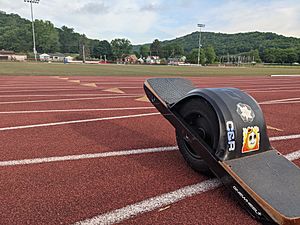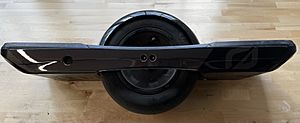Onewheel facts for kids
The Onewheel is a cool electric board that balances itself on a single wheel! You can think of it like an electric skateboard, but instead of four wheels, it has just one big one in the middle. Riders stand with their feet sideways, similar to how you'd stand on a snowboard or surfboard. It's a fun way to get around or just cruise!
Contents
How Onewheel Started
The idea for a Onewheel-like device first came about in 2007. Later, a person named Kyle Doerksen, who is the founder and CEO of Future Motion Inc., created the commercial version we know today. Kyle studied engineering at Stanford University.
In 2013, Kyle started his company, Future Motion Inc., in Santa Cruz, California. He launched the Onewheel on Kickstarter in January 2014. Kickstarter is a website where people can help fund new ideas. Kyle's project was a huge success! It quickly raised over $630,000, much more than his goal of $100,000.
The first Onewheel came out in 2015. Since then, new and improved versions have been released:
- The Onewheel+ in 2017
- The Onewheel+ XR in 2018
- The Onewheel Pint in 2019
Future Motion Inc. started in Mountain View, California, but later moved to Santa Cruz in 2015. The Onewheel boards are made right there in Santa Cruz, in a large factory.
Onewheel Races
In 2015, Onewheel started its first "Race for the Rail" event. In these races, riders compete on mountain bike trails for a cash prize.
In 2020, the race was held at a secret ski resort in Utah. This was done to keep the number of people watching low because of the coronavirus pandemic. The final races were shown live online on YouTube. In 2022, the race took place in Reno, Nevada, where riders raced down hills at Sky Tavern Resort. Racheal Cecil and Kyle Hanson were the champions that year!
Different Onewheel Models
Over the years, Future Motion has released several different Onewheel models, each with its own features.
Original Onewheel
This was the very first model. It could travel about 4–6 mi (6.5–9.5 km) on a single charge and had a top speed of about 13 mph (20 km/h). This model is no longer made.
Onewheel+
Released in 2017, the Onewheel+ was an improved version. It had a slightly better range of 5–7 mi (8–11.5 km) and a faster top speed of 19 mph (30 km/h). This model was also later discontinued.
Onewheel+ XR
The Onewheel+ XR came out in 2018. It offered a much longer range of 12–18 mi (20–30 km) and a top speed of 19 mph (30 km/h). This model was very popular with riders because of its long range, speed, and how tough it is. It was officially discontinued in 2021, but for a short time in 2022, some extra ones were sold again.
Onewheel Pint
The Onewheel Pint is a smaller model, released in 2019. It has a range of 6–8 mi (9.5–13 km) and a top speed of 16 mph (25 km/h). The Pint has a cool LED light display that shows how much battery is left. It also has a handle, which makes it easier to carry. This model is still being made today.
Onewheel Pint X
In October 2021, Onewheel announced two new models, including the Pint X. The Pint X is a faster version of the Pint, reaching speeds of 18 mph (30 km/h). It also has a much longer range, similar to the XR, at 12–18 mi (19.5–29 km).
Onewheel GT
The Onewheel GT was also introduced in October 2021. It's the fastest model, with a top speed of 20 mph (30 km/h), and has the longest range, from 20–32 mi (32–51.5 km). The GT uses a slightly larger wheel hub than older models. When the GT first came out, some people reported issues with boards not working right away or speeding up by themselves without a rider.
How Onewheels Work
The Onewheel's single wheel has a special electric motor inside. This motor spins to move you forward or backward. It also makes tiny, constant adjustments to help you stay balanced.
To ride, you place your feet on pads on either side of the wheel. Your front foot goes on a special pad that knows when you're standing on the board. To steer, you simply lean slightly in the direction you want to go. To stop, you lift your heel off the front footpad. The Onewheel Pint and GT models have a special feature called Simplestop. With this, you can lean back to make the board stop slowly, allowing you to step off easily. You can turn this feature on or off in the Onewheel app.
Every Onewheel has three special sensors called accelerometers and gyroscopes. These sensors constantly measure how the board is tilted. They take readings about 14,000 times every second! This information tells the motor exactly what to do to help you balance and move.
All Onewheel models use a safety feature called 'Pushback'. This gently lifts the nose of the board when you get close to the maximum safe speed. This feeling tells you that you need to slow down.
Riders can also use a special app on their phone. This app shows how much battery charge is left and how many miles you've ridden. You can also use the app to change how the board responds to your riding style, making it feel just right for you.
Important Safety Information
Future Motion, the company that makes Onewheels, has faced some concerns regarding repairs and safety.
Repairing Onewheels
It can be difficult to get a Onewheel repaired outside of Future Motion's main repair center in California. This means that if something breaks or you need a new tire, you might have to send your board a long way, which can be expensive. Some people believe it should be easier for other shops to fix Onewheels.
Onewheel GT Issues
When the Onewheel GT first launched, some riders reported problems where the board would speed up by itself without anyone on it. This was called "ghosting." To fix this, Future Motion announced in August 2022 that they would voluntarily recall some front footpads for the Onewheel GT to address this issue.
Safety Warning
In November 2022, the U.S. Consumer Product Safety Commission (CPSC), a government agency that helps keep products safe, issued a warning. They suggested that people stop using all Onewheel units sold since 2014. They were concerned that riders could be thrown off the product. Future Motion disagreed with this warning. They stated that Onewheel products are safe if riders follow basic safety rules, like wearing a helmet and other protective gear, just like with any other board sport. Future Motion has also started a petition, and many users have shared positive experiences about riding Onewheels.
Customizing Your Onewheel
There's a community of people who create and sell cool add-ons for Onewheels. These can include:
- Bigger battery packs for longer rides
- Small extra wheels called "fangs"
- Protective plates called "bumpers"
- Different types of grip tape for your feet
See also
- Electric skateboard
- Electric unicycle
- Monowheel
- Personal transporter
- Self-balancing scooter





